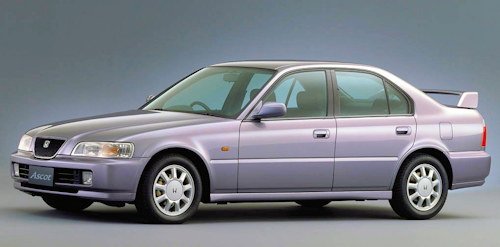Honda Ascot Second generation (CE)
 | |
Make | Honda |
Production | 1993–1997 |
Body style | 4-door sedan |
Engine | 2.5 L G25A1 I5 |
Transmission | 4-speed automatic |
Wheelbase | 2,770 mm (109.1 in) |
Length | 4,555 mm (179.3 in) |
Width | 1,695 mm (66.7 in) |
Height | 1,425 mm (56.1 in) |
Curb weight | 1,280 kg (2,821.9 lb) (G20A engine) |
The Honda Ascot (Japanese: ホンダ・アスコット, Honda Asukotto) is a compact sedan manufactured by Honda and marketed only in Japan from 1989 to 1997.
History
The first generation produced two versions based on the Honda Accord CB series called the Ascot and from 1993 to 1996 a "pillared hardtop" called the Ascot Innova. The Innova shared much of its mechanicals with the European-market Accord manufactured at the Honda UK facility in Swindon, England, and was essentially the badge engineered Rover 600. The second generation was a platform improvement, shared with the Japan-only sedan called the Honda Rafaga. The "Ascot" name was chosen with reference to the Ascot Racecourse and Ascot tie, in order to add the model an alleged air of class and elegance. Honda Ascot was also used on a range of one-cylinder motorcycles in the first half of the 1980s.
The Second-generation (CD) Accord grew in size significantly, mostly to meet North American market demands, and so became too large to fit into Japan's favourable tax class. As a result, Honda needed a somewhat smaller compact sedan to cater to the Japanese market, and the new Ascot was given the task. Rather than being based directly on the now-larger Accord, the new Ascot was given its own platform, codenamed CE4/5, which was an advance over the previous generation's architecture.Like the Inspire, Vigor and the even larger Honda Legend, the CE Ascot had its engines mounted longitudinally, contrary to the Accord and most other FWD cars, employing the transverse setup, thereby placing the weight of the engine aligned and behind the front axle and improving vehicle weight distribution between the front and rear axles. In Japan, the smaller G20A engine used regular grade fuel, while the larger G25A engine used premium grade fuel.
The new Ascot had a sloping, coupé-like design, making it shorter and taller than the CD Accord, Ascot Innova, and Inspire, and therefore continuing the function of the first Ascot as a luxury entry-level formal sedan. It came with a 5-cylinder inline Honda G engine, which was also used in the Inspire and Vigor, and was available in two displacements: 2.0 litre and 2.5 litre, with the gearbox mounted behind it. The Ascot's wheelbase was 35 mm (1.4 in) shorter than the slightly longer Inspire and Vigor's, which measured 2,805 mm (110.4 in). This didn't allow much room for back seat passengers.
Furthermore, due to the lengthwise installation of the five-cylinder engine, and the requirement that the overall length of the car comply with Japanese government regulations concerning cars classified as "compact", compromises were made with regards to rear passenger accommodations, and sales suffered as a result. The Ascot also spawned a sister car, the Honda Rafaga, which was sold at Honda Verno stores, which differed from the Ascot only by different external trim details. Both models were replaced by the CF series Accord platform twin Honda Torneo in 1997.




